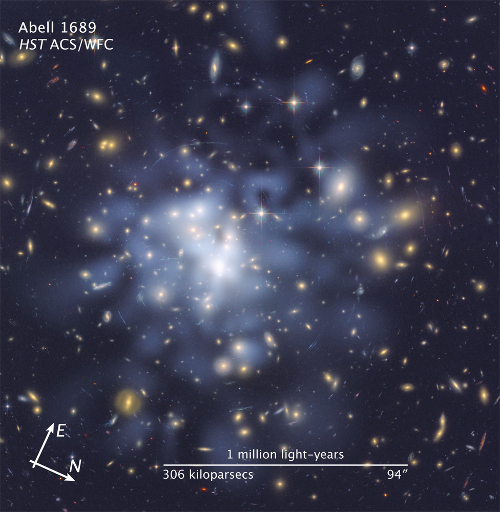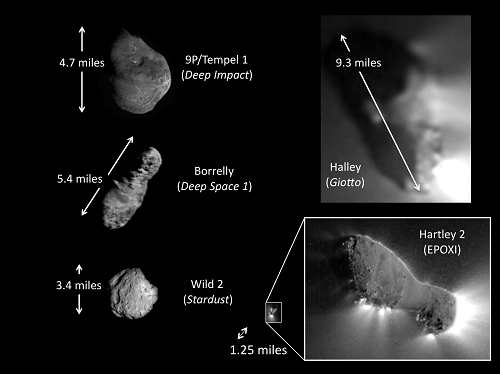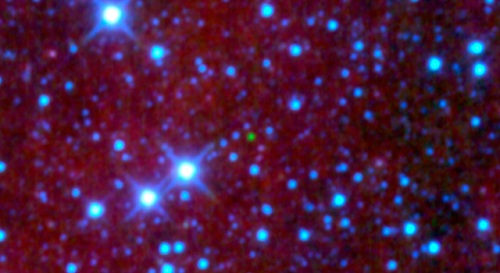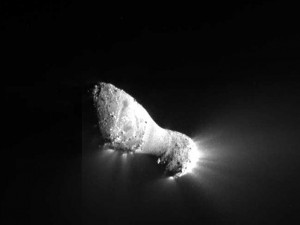Centauri Dreams
Imagining and Planning Interstellar Exploration
Gravitational Lensing Probes Dark Energy
Abell 1689 is one of the most massive clusters of galaxies known, making it a superb venue for the study of dark matter. That’s because the cluster, some 2.2 billion light years away, creates gravitational lensing that magnifies and distorts the light from galaxies far beyond it. Astronomers used Abell 1689 in 2008 to identify one of the youngest and brightest galaxies ever seen, a galaxy in existence a mere 700 million years after the beginning of the universe. That find, A1689-zD1, turned out to be ablaze with star formation in an era when stars were only beginning to emerge.
New Hubble studies have now used Abell 1689 yet again to make some of the most detailed maps yet of dark matter. The idea is this: The cluster’s gravitational lensing bends and amplifies the light of objects beyond it. The researchers, led by JPL’s Dan Coe, go to work on the distorted images that result, figuring out the mass it would take to produce them. If the galaxies we see in the cluster were the sole source of gravity, the distortions would be much weaker. To straighten out the images, then, requires a great deal of dark matter within the cluster.
Image: Compass and Scale Image for Abell 1689 Dark Matter Map. Credit: NASA, ESA, D. Coe (NASA, Jet Propulsion Laboratory/California Institute of Technology, and Space Telescope Science Institute), N. Benitez (Institute of Astrophysics of Andulusia, Spain), T. Broadhurst (University of the Basque Country, Spain), and H. Ford (Johns Hopkins University).
The lensing effect is powerful, with the Coe team finding 135 multiple images of 42 background galaxies at distances ranging from 7 to 12 billion light years. The map of dark matter distribution that results from this work, if verified, would represent the highest resolution depiction of a galactic cluster’s dark matter distribution yet produced. It’s a particularly interesting result because the effects of dark energy, pushing against the gravitational pull of dark matter, should have had a disruptive effect on the growth of the cluster. The results parallel studies of other galactic clusters with dense cores, leading Coe to this conclusion:
“Galaxy clusters, therefore, would had to have started forming billions of years earlier in order to build up to the numbers we see today. At earlier times, the universe was smaller and more densely packed with dark matter. Abell 1689 appears to have been well fed at birth by the dense matter surrounding it in the early universe. The cluster has carried this bulk with it through its adult life to appear as we observe it today.”
Galaxy clusters, in other words, probably formed earlier than previously thought, before dark energy could go to work to inhibit their growth. Coe’s work with mathematician Edward Fuselier has produced new techniques for calculating the dark energy map, a feat the scientist likens to ‘cracking the code’ of gravitational lensing. Adds Coe:
“Other methods are based on making a series of guesses as to what the mass map is, and then astronomers find the one that best fits the data. Using our method, we can obtain, directly from the data, a mass map that gives a perfect fit.”
The analysis method in play is called LensPerfect, described this way in the paper on this work:
LensPerfect is a novel approach to gravitational lens mass map reconstruction. The 100+ SL features produced by A1689 present us with a large puzzle. We must produce a mass model of A1689 with the correct amounts of mass in all the right places to deflect light from 30+ background galaxies into multiple paths such that they arrive at the 100+ positions observed.
Most SL [strong gravitational lensing] analysis methods construct many possible models and then iterate to find that which best matches the data. LensPerfect instead uses direct matrix inversion to find perfect solutions to the input data. Using LensPerfect, we may, for the first time, obtain a mass map solution which perfectly12 reproduces the input positions of all 100+ multiple images observed in A1689.
Gravitational lens work, then, involves reconstructing the actual mass distribution based on the highly magnified and distorted images produced by the lensing. It’s no small feat, but dark matter and dark energy are among the highest priority targets for modern science. Sharpening our tools for understanding what lensing is telling us is a step toward understanding both. This work studies dark energy through matter which, though dark, is increasingly within the grasp of study because of its profound effects on spacetime at the galactic cluster scale.
More clusters are to be studied in the same way through the Cluster Lensing and Supernova survey with Hubble (CLASH) program, which will examine 25 clusters over the course of the next three years. Conclusive evidence of early cluster formation may help us put some boundaries on dark energy in the early universe. Let’s hope so, for a universe of which we see and understand a mere four percent (the rest being dark matter and dark energy) is a challenge that energizes the very heart of physics.
The paper is Coe et al., “A High-Resolution Mass Map of Galaxy Cluster Substructure: LensPerfect Analysis of A1689,” The Astrophysical Journal 722 (2010), pp. 1-25 (abstract).

Hartley 2: Primordial Dry Ice
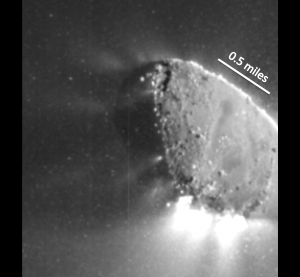
Keep an eye on the EPOXI site at the University of Maryland. New images from the Hartley 2 comet encounter are coming in, some of them truly breathtaking, as is the one at left. The jets clearly visible in the image can be linked with distinct areas on the surface of the comet, the first time we’ve ever seen a comet with this degree of clarity. Image by image, the tiny comet is yielding its secrets. We now learn that spectral analysis of the material coming from the cometary jets shows it to be primarily carbon dioxide, along with dust and ice particles.
Image: This enhanced image, one of the closest taken of comet Hartley 2 by NASA’s EPOXI mission, shows jets and where they originate from the surface. There are jets outgassing from the sunward side, the night side, and along the terminator — the line between the two sides. The image was taken by EPOXI’s Medium-Resolution Instrument on Nov. 4, 2010. The sun is to the right. Credit: NASA/JPL-Caltech/UMD.
Jessica Sunshine (University of Maryland), the mission’s deputy principal investigator, puts the findings in context:
“Previously it was thought that water vapor from water ice was the propulsive force behind jets of material coming off of the body, or nucleus, of comet. We now have unambiguous evidence that solar heating of subsurface frozen carbon dioxide (dry ice), directly to a gas, a process known as sublimation, is powering the many jets of material coming from the comet. This is a finding that only could have been made by traveling to a comet, because ground based telescopes can’t detect CO2 and current space telescopes aren’t tuned to look for this gas.”
With new data arriving at the rate of 2000 images a day, we should have much more to look forward to from Hartley 2, but the amount of carbon dioxide escaping the comet has proven to be the biggest surprise so far. It’s fascinating to realize that the dry ice producing the jets we see in the images has most likely been inside the comet since the earliest days of the Solar System. The EPOXI findings are consistent with what Deep Impact found at Tempel 1 back in 2005, though mission scientist Tony Farnham (University of Maryland) explains why the Tempel 1 results were less conclusive:
“Tempel 1 was most active before perihelion when its southern hemisphere, the hemisphere that appeared to be enhanced in CO2, was exposed to sunlight. Unlike our Hartley encounter, during the flyby with Tempel 1, we were unable to directly trace the CO2 to the surface, because the pole was in darkness during encounter.”
Taking Deep Impact to a second comet, then, has paid big dividends in the Hartley 2 data, which now point to carbon dioxide rather than water as the driver for cometary surface activity here and likely on other comets. We’re learning about comets step by step — EPOXI’s mission marks only the fifth time we’ve had close-up imagery of one — but we’re finding things no ground-based telescope could show us. The montage below puts all five cometary investigations into perspective.
Image: This montage shows the only five comets imaged up close with spacecraft. The comets vary in shape and size. Comet Hartley 2 is by far the smallest and has the most activity in relation to its surface area. This jet activity can be seen extending from the comet’s surface and into its outer shell of gas and dust, or coma. This is the first time scientists have been able to link jets to the details of the surface. Credit: NASA/JPL-Caltech/UMD.

WISE: First Ultra-cool Brown Dwarf
“To a man with a hammer, everything looks like a nail,” said Mark Twain, one take on which is that the way we see problems shapes how we see solutions. That fact can be either confining or liberating depending on how open we are to examining our preconceptions, but in the case of Amy Mainzer (JPL), it leads to a natural way to describe a failed star. Mainzer, who is deputy project scientist on the Wide-field Infrared Survey Explorer mission (WISE), is an amateur jewelry-maker. For her, it’s easy to look at the image below and see gems. “The brown dwarfs,” says Mainzer, “jump out at you like big, fat, green emeralds.”
And that emerald below, dead center in the image, is hard to miss.
Image: The green dot in the middle of this image might look like an emerald amidst glittering diamonds, but it is actually a dim star belonging to a class called brown dwarfs. This particular object, named “WISEPC J045853.90+643451.9” after its location in the sky, is the first ultra-cool brown dwarf discovered by NASA’s Wide-field Infrared Survey Explorer, or WISE. WISE is scanning the skies in infrared light, picking up the signatures of all sort of cosmic gems, including brown dwarfs. Credit: NASA/JPL-Caltech/UCLA.
The brown dwarf in question is somewhere between 18 and 30 light years away in the constellation Camelopardalis (the giraffe), and is one of the coolest such objects known, with a temperature of roughly 600 Kelvin (326 degrees Celsius). This is one of those brown dwarfs that burn at temperatures close to a hot oven here on Earth, cool enough that it takes WISE’s infrared view from space to pick it up. In the image, we’re looking at three of the four WISE infrared channels, color-coded so that blue shows the shortest infrared wavelengths and red the longest. The methane in the brown dwarf atmosphere absorbs the blue-coded light and the faint object gives off little of the red, leaving green as the dominant color.
The best news about the new brown dwarf is that it turned up a mere 57 days into the survey mission, meaning that WISE is on track to find many more. Given how hard they are to spot, the possibility of an ultracool brown dwarf being in the Sun’s neighborhood, and perhaps closer than the Alpha Centauri stars, cannot be ruled out. In any case, mission planners think WISE will find hundreds of the objects within a few parsecs of the Sun. And who knows, we may yet find a perturbing body whose presence accounts for anomalous orbits like that of Sedna.
Remember this: Back in June, we learned that the Spitzer Space Telescope had found fourteen of the coldest brown dwarfs then known, so faint that visible light telescopes could not find them. The Spitzer study focused on a region in the constellation Boötes, whereas WISE will be looking at the entire sky. Peter Eisenhardt, a WISE project scientist at JPL, puts it this way:
“WISE is looking everywhere, so the coolest brown dwarfs are going to pop up all around us. We might even find a cool brown dwarf that is closer to us than Proxima Centauri, the closest known star. WISE is going to transform our view of the solar neighborhood. We’ll be studying these new neighbors in minute detail — they may contain the nearest planetary system to our own.”
We’ve only been able to confirm the existence of brown dwarfs for fifteen years, and we certainly aren’t through classifying them. T dwarfs are defined as being less than about 1500 Kelvin (1226 Celsius), but the colder class of Y dwarfs, found in stellar models but not yet confirmed, makes for prime hunting for WISE, which should be able to detect them. Are there more brown dwarfs within 25 light years of the Sun than normal stars? WISE should be able to tell us, and in doing so may tune up our target list for future deep space missions into the Oort Cloud and beyond.

The Poetry of SETI
Stephen Baxter’s “Turing’s Apples,” which originally ran in a collection called Eclipse Two (2008), is an intriguing take on SETI and the problem of extracting meaningful information from a signal. It’s a bit reminiscent of Fred Hoyle’s A for Andromeda (1962) in that the SETI signal received on Earth contains instructions for building something that may or may not pose a threat to our species. Sorting out the issue involves discussion of information theory and Shannon entropy analysis.

Say again? Best to handle this by quoting from the story. In this scene, the protagonist’s brother, who is obsessed with the signal his team has received from the direction of the Eagle Nebula and, ultimately, the galactic center, is explaining how information is being extracted from it. Shannon entropy analysis looks for relationships between signal elements. The brother goes on:
“You work out conditional probabilities: Given pairs of elements, how likely is it that you’ll see U following Q? Then you go on to higher-order ‘entropy levels,’ in the jargon, starting with triples: How likely is it to find G following I and N?
“As a comparison, dolphin languages get to third- or fourth-order entropy. We humans get to eighth or ninth.”
“And the Eaglets?”
“The entropy level breaks our assessment routines. We think it’s around thirty…It is information, but much more complex than any human language. It might be like English sentences with a fantastically convoluted structure – triple or quadruple negatives, overlapping clauses, tense changes.” He grinned. “Or triple entendres. Or quadruples.”
“They’re smarter than us.”
“Oh yes…”
And that reminds me of an old friend, an amateur linguist but an extraordinary one, who once at a memorable lunch pulled off a triple pun involving three different languages, one of which was proto-Hebraic! I had to be led through its complexities before I could begin to appreciate it (and that only after I thought about it for the rest of the day). Now that’s high-level entropy…
I had the pleasure of talking about the Baxter story with Claudio Maccone over dinner last weekend in Austin. Claudio was on his way to the SETI Institute to give a lecture on the latest work on his statistical approach to the Drake Equation. The potential encounter with intelligence far greater than our own is what accounts for the fascination of SETI. No one knows whether we are alone in the galaxy or simply outliers amidst a sea of extraterrestrial civilizations, but the engagement with the latter possibility energizes a search that is now fifty years old.
Last week saw global coordination among SETI researchers as a way of marking that 50th anniversary, with astronomers from thirteen countries on six continents observing several nearby stars including the two that started it all, Epsilon Eridani and Tau Ceti. It was in April of 1960 that Frank Drake used the Green Bank instrument in West Virginia to listen in on the latter two stars. Project Ozma drew its name from The Wonderful Wizard of Oz, so the ongoing Project Dorothy picks up the theme by associating itself with that story’s heroine. The Project Dorothy observations involve both radio and laser signals, unlike the radio-only Project Ozma.
But the project is something more than merely commemorative. If one day we do receive a signal that appears to be the real thing, we’ll need to coordinate observations on a global scale. The SETI Institute’s Douglas Vakoch makes the point:
“Astronomers can now do SETI research at observatories from South Africa to the Netherlands, from Argentina to India, from Japan to Italy, as well as from the longstanding American projects at the SETI Institute, the University of California at Berkeley, and Harvard University. The lessons learned through Project Dorothy provide critical preparation for the day we finally detect a signal from another civilization. By learning how to coordinate international SETI observations now, we’ll be better prepared to track a signal continuously, around the world, after first contact.”
This Washington Post story discusses SETI basics and the new international exercise, which includes observatories in Italy, India, Argentina, Australia, France, Germany, the United Kingdom, South Korea, Sweden, the Netherlands, and several in the United States and Japan. Behind the observations is Shin-ya Narusawa (Nishi-Harima Astronomical Observatory, Japan), who notes the value of studying Tau Ceti and Epsilon Eridani in the venture. “They remain the symbol of the project Ozma,” Narusawa said, “and so are two of the target stars for Project Dorothy.”
We have reasons for doubting either of these stars might support an extraterrestrial civilization, but for that matter we have no confirmed rocky planet in the habitable zone of any star (and yes, that includes the hypothetical Gliese 581g, whose existence seems more and more unlikely). If SETI ever does get its breakthrough, it will be because we didn’t narrow the search too drastically based on our own assumptions, but remained open to the possibility of surprise.
Read the Baxter story for one take on SETI and surprise (it’s in the 26th annual Year’s Best Science Fiction volume edited by Gardner Dozois). But if you read no other science fiction on the subject, read James Gunn’s superb The Listeners (1972), as fine a take on the wonder-injecting business of listening to deep space as has ever been penned. It was, among other things, an inspiration for Sagan’s Contact. Gunn on SETI and the human spirit:
“…perhaps it was not just the reality but the imagery, like poetry, that soothed their doubting souls, the bowl held up to catch Donne’s falling star, the ear cocked to hear the shout from the other side of the universe that faded to an indistinguishable murmur by the time it reached them. And one thousand miles above them was the giant, five-mile-in-diameter network, the largest radio telescope ever built, that men had cast into the heavens to catch the stars.”

Of Comets and Deep Space Aspirations
The Hartley 2 flyby was an outstanding event, and the only thing I regret about my recent travels was that I was unable to follow the action as the images first streamed in. By now, sights like the one at left have made their way all over the Net, so I won’t dwell on them other than to say that if you haven’t seen the short video clip of the EPOXI flyby, you should definitely give it a look. You’re getting the view from a spacecraft that closed to 700 kilometers or so of the surface, during an encounter taking place at a speed of 12.3 kilometers per second.
Image: Comet Hartley 2 can be seen in glorious detail in this image from NASA’s EPOXI mission. It was taken as the spacecraft flew by around 6:59 a.m. PDT (9:59 a.m. EDT), from a distance of about 700 kilometers (435 miles). Jets can be seen streaming out of the nucleus. Image credit: NASA/JPL-Caltech/UMD.
I’ll go along with EPOXI principal investigator Michael A’Hearn’s description of the comet’s “stark, majestic beauty.” Interesting to learn that Hartley 2 has a hundred times less volume than comet Tempel 1, which was Deep Impact’s first target, but there’s plenty still to learn from the data that streamed in from 37 million kilometers away. Adds A’Hearn (University of Maryland, College Park):
“Early observations of the comet show that, for the first time, we may be able to connect activity to individual features on the nucleus. We certainly have our hands full. The images are full of great cometary data, and that’s what we hoped for.”
Thus we get the most extensive observations of a comet in history. This is the first time that two comets have been imaged by the same spacecraft and at the same spatial resolution. What next for Deep Impact and the EPOXI mission? Interestingly, the spacecraft has enough usable fuel, about four kilograms, to support continued science observations even after the Hartley 2 flyby. We’ll have to see whether tasking it with a new assignment is in the cards.
Hartley 2 has been under scrutiny from other sources as well, including the Odin satellite, a Swedish spacecraft created in collaboration with Canada, Finland and France. Odin studied Hartley 2 at the end of October and was able to detect its water signature line at 556.9 GHz with ease, as shown in the image. The rapid variations in water production are thought to be related to the rotation of the comet’s nucleus. Water vapor is released as the cometary nucleus is heated by the Sun — recall that Hartley 2 passed perihelion as recently as 28 October.
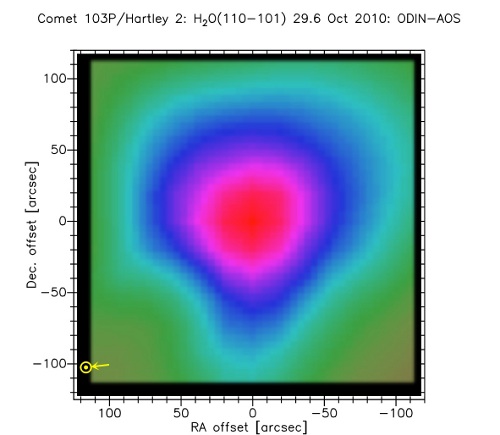
Image: A map of water in Comet Hartley 2, observed by Odin on 29 October 2010. Copyright 2010 Swedish Space Corporation/Centre National d’Etudes Spatiales/Observatoire de Paris.
With Hartley 2 creating a celestial display as cometary dust burns up in the Earth’s atmosphere (the comet passed within 19 million kilometers of our planet on 20 October), this is a comet we’ll long remember. Unfortunately, for me it’s associated with a long airline flight and a developing cold that settled in halfway home. It’s amazing how someone who writes so much about going to the stars dislikes all aspects of travel, but it’s the truth, and that reminds me of a story.
Some years back I talked with Bob Forward, Robert Forward’s son, about his late father. The elder Forward was, of course, a towering figure in interstellar studies, changing our perception of what is possible in terms of delivering payloads to other star systems. Bob told me that one night he asked his father this question: If an alien spacecraft landed on the front yard and you were invited to go out into the universe, with the proviso that you could never come back, would you go? And Robert Forward answered instantly (to the dismay of wife Martha), “Of course!”
Consternation reigned. Would Forward really leave his family behind to go to the stars? Well, yes. “You have to understand,” he went on to say. “This is what I have dreamed about all my life.”
I love the story, but I can only say that I’m on a different page. If the spacecraft lands, I’m all for somebody getting on board, but it won’t be me. What I do hope is that whoever goes has some way to get data back to Earth so I can write the story here. This morning, fighting a fever and a sore throat, nursing a lemon-and-honey hot toddy, I’m thinking that home has its charms, and I’m about ready to get back into bed.

Beyond Hartley 2: EPOXI’s Hunt for Exoplanets
I had hoped to be able to cover the Hartley 2 flyby today, but I’m traveling on Tau Zero business and have to write this entry early. Instead, I’ll at least keep the EPOXI mission focus by talking about the other half of this unique venture, an investigation of exoplanet systems. We can always talk about what the Hartley 2 encounter produced next week, but not before, as the schedule is crowded and I doubt I’ll be able to get an entry posted here at all on Friday.
Remember that the Deep Impact spacecraft that visited Tempel 1 in 2005 is now on an adventuresome extended mission called EPOXI (although the spacecraft, confusingly enough, still retains the original ‘Deep Impact’ name). The spacecraft was reawakened in the fall of 2007 and directed to a flyby of the Earth for a gravitational assist that would put it into a heliocentric orbit for the Hartley 2 encounter.
On the cruise portion of that journey, the extrasolar component of the mission kicked in. EPOCh (Extrasolar Planet Observation and Characterization) is the name of that investigation, the observing phase of which began in January of 2008 and ran until August of that year. A deep search of a nearby red dwarf star looking for a planet comparable in size to the Earth has been part of the larger EPOCh study.
33 light years from Earth, GJ 436 is known to host a Neptune-sized planet that transits every 2.6 days. The fact that GJ 436b’s orbit is slightly eccentric has drawn the attention of researchers interested in whether an unseen planet is behind the eccentricity, perhaps one as small as the Earth. Three weeks of continuous observations produced an excellent lightcurve of the Neptune-class world, but despite the fact that the potential planet was expected to orbit nearly edge-on to our line of sight, no transit or other data signature for it was found.
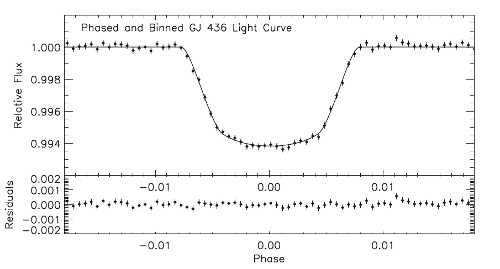
Image: EPOCh data for the transit of the Neptune-sized planet orbiting the red dwarf star GJ436. Using data of this quality, EPOCh was able to attain sensitivity to planets as small as 1.5 Earth radii. Credit: Ballard et al. 2010, Astrophysical Journal, Vol. 716, p. 1047.
The team is able to rule out transiting planets over 1.5 Earth radii to a high degree of confidence. Even in the absence of a transit, variations in the transits of the known planet could signal the existence of further planets. So is there a GJ 436c, or is there some other explanation for the eccentricity of GJ 436b’s orbit? Drake Deming, deputy principal investigator for EPOCh), has this to say in a post on the EPOXI site:
[The] negative result has provided motivation for theorists to consider that GJ436c may not exist. Theorists are re-examining their original conclusion that the orbital eccentricity of GJ436b requires the presence of a second planet. It is possible that tidal forces from the star are not sufficient — even in the absence of a second planet — to quickly drive the orbit of GJ436b to a circular state, as had been previously believed. That would obviate the need for GJ436c, but would require the interior structure of GJ436b to be unlike the gaseous planets of our solar system.
GJ 436 is one of eight stars chosen for the original EPOCh survey, all known to have other transiting planets. The other transiting planet systems included HAT-P-4, TrES-2, TrES-3, XO-2, GJ436, WASP-3, and HAT-P-7. In addition to finding new worlds, intense study of the known transiting planets could reveal the existence of moons or rings around the planet. The EPOCh team has now moved from processing the data to writing papers about the results.
But EPOCh isn’t through yet. Using the same data analysis technique developed for the mission and employed with GJ 436 data, researchers will soon be working with data from the Spitzer Space Telescope. The Deep Impact spacecraft may have Hartley 2 in its sights, but the EPOCh team will be looking to Spitzer’s investigation of the red dwarf system GJ 1214, some 42 light years from Earth. The Spitzer search, to be conducted in the spring of 2011, targets the habitable zone around this star, and the analytical tools developed for EPOCh coupled with Spitzer’s results could theoretically detect a planet here that is even smaller than the Earth.
Thus a spacecraft designed to drive an impactor into a comet — and one that has been re-purposed for a second comet encounter — produces exoplanet data and new analytical techniques that will now mesh with results from a space-based telescope (not to mention its studies of the Earth from space, that provide information about how to observe Earth-like planets at long range). No question about it, Deep Impact has given us plenty of bang for the buck.
You can find more about the EPOCh targets here, and ponder as I do what may turn up in the subsequent analysis of EPOXI and Spitzer data. The paper is Ballard et al., “A Search for Additional Planets in the NASA EPOXI Observations of the Exoplanet System GJ 436,” The Astrophysical Journal Vol. 716, Number 2 (20 June, 2010). Abstract available.

